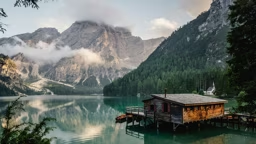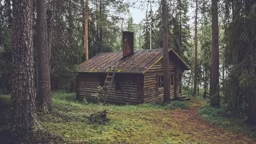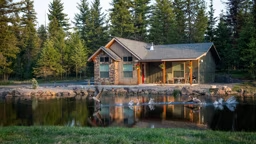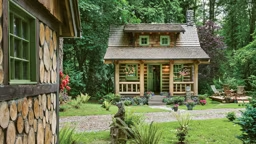
Alicia has a dilemma. She and her husband, James, bought out his siblings so that they are now the sole owners of his family’s 75-year-old camp on a small lake in New York’s popular Lake George vacation area. The dilemma: “After putting on a new roof last year, we are starting to look past the love and memories and [toward] my husband’s fantasy of fixing up the place to look like a mountain lodge,” Alicia says. But, as the 50-something couple ponders their dream, their aging camp is giving them reasons to question whether it’s a fixer-upper or a demo/rebuild project. Alicia lists her other concerns: The cabin is set upon crumbling pilings that need repair (they have quotes from $3,000 to $10,000); two rooms need ceilings; the patched-in bathroom is falling apart and attracting carpenter ants; the kitchen is okay, but worn; and the ancient linoleum is curling up.
Like Alicia and James, many families are wondering whether it’s best to renovate or rebuild their cabin. So, we called in a couple of experts to help us answer that question. Architect Nathan Good, of Portland, Ore., has been honored as one of the top 50 architects in the Northwest. Cabin builder/remodeler Greg Amundson, of Scandia, Minn., has 25 years of experience and has designed and built well over 50 custom homes. When staring down the renovate-versus-rebuild dilemma, Amundson and Good recommend you start the decision-making process by asking these six questions:
1. Is there a historic or personal reason to keep the existing structure (or parts of it)?
Before you get out the sledgehammer, make sure you’re not tearing down something that’s irreplaceable. If your cabin has been in the family for generations or it was a big part of your upbringing, you may have cherished family memories tied to the cabin’s look, feel and smell. Yes, even smell!
“Oftentimes, an old cabin has a certain nostalgic aroma that can never be re-created,” Amundson says. Or maybe there are significant historical or architectural reasons for keeping the original structure – details like heart-pine flooring in a northwoods cabin or built-ins with beadboard wainscoting in a Maine cottage. A renovation can preserve those things in part or in whole.
“For example,” Amundson says, “a small cabin with a unique Adirondack style could become the great room of a new, larger addition. Of course, the condition will play a huge factor in determining if you can use the existing structure.” If you want to keep these character-imbued details but can’t salvage the cabin itself, consider reclaiming the materials and reusing them in the new building.
2. How are your cabin’s bones?
If an inspector says your cabin has “good bones,” that means it was designed and built well, a blessing that has allowed it to age well so that it’s still structurally sound. A cabin with good bones likely boasts these traits:
- A solid, intact foundation
-
Solid, level floors
-
A strong roof
-
Good ceiling heights
-
Plenty of light from adequately sized windows.
When you’re conducting a DIY evaluation, Amundson suggests you look at these key areas:
-
In old bathroom and toilet areas, inspect the walls and floors for mold and rot.
-
Check the roof for signs of “saddleback” – like you might see on an old horse. Does the ridge sag? If so, does the attic offer adequate work space for you to reinforce the roof?
-
Are there any termite or other bug infestations?
-
If you have a log home, are any logs rotten, especially the logs nearest the ground?
If you have doubts about the structural integrity of your place, Good recommends you bring in a structural engineer to help assess it. This process can range from about $500 for a visual inspection to around $3,000 for a more detailed, thorough analysis that involves calculations. Another option is to hire a home inspector, which will likely cost around $350. These experts can make recommendations about the condition of the structure and what work might need to be done to make the place match your vision. That could mean renovating, but if there are major structural issues that will be difficult to repair or excessive mold issues, the building may not be worth salvaging.
3. Are there setbacks and/or taxes to consider?
This may be the single most important reason to keep an existing structure today. Many old lake cabins enjoy close proximity to the shore, and those owners usually want to keep it that way. If you own such a place and rebuild, you may be forced to set your new cabin farther back from the water’s edge.
However, if you request a building permit to simply add on to your existing structure, your local zoning board might allow you to keep your existing setback based on historical exemption. Sometimes, retaining just one “wall” of the original structure is enough to qualify. Other than distance from the water, your renovating/rebuilding options may be constrained by other setback requirements – for your septic system, driveway, deck, outbuildings, etc. – that involve distances not just from water bodies, but also from roads and/or your neighbors’ properties. Check your local zoning laws; rules can be very different in each municipality.
Depending on the regulations and your wish list, you may not be able to achieve your vision by renovating; you may have to rebuild with some clever design solutions. Also, consider possible tax ramifications. In some states, there are tax benefits for remodeling but not for rebuilding. And rebuilding might mean an entire, new assessment of your property, which may result in a much higher property-tax bill. Most important of all, Good says, make sure your builder or remodeler pulls a building permit, regardless of the size of your project.
4. Have you done a cost comparison?
The costs of renovating versus tearing down and rebuilding can vary widely. If you’re renovating, Good has a word of advice: “When you’re stripping off that siding or drywall to add insulation, resist the temptation to make structural changes.” He’s seen cabin owners succumb to the dream of adding a vaulted ceiling or moving this window here and that one there, resulting in major cost overages. Amundson explains that a lot of renovating costs depend on mechanical systems and how old they are. “For example, a pre-1950s cabin may have the old insulated electrical wiring in the walls,” he says. His team would need to replace the wiring and add a new electrical panel, a process that involves removing all of the old material down to the original studs. While they’re in there, the crew looks for rot and mold. “There are oftentimes many surprises in the walls,” he says.
But he notes that demolishing a cabin in order to rebuild may also yield surprises, like asbestos-containing siding or flooring. Amundson says that while costs to demo range from around $10,000 to $20,000 depending on the size of the job and distance to the landfill, hazardous materials can add to the cost. Some cabin owners elect to do the demo themselves in order to donate some of the material or reuse it in the new place. “These are great intentions,” Amundson says, “but understand that it is a very difficult job and you want to make sure you are not holding up your contractor by doing so.”
See also: Borrowing Money to Rebuild or Remodel a Cabin
5. How will your decision impact your well and septic system?
A new cabin probably means a new septic system. But if your renovation means adding bedrooms and bathrooms, you may need a new septic system to handle the increased demands as well. Besides, Amundson points out, “the requirements for septic systems have changed dramatically, and all municipalities have this item at the top of their list for any building permit.” When planning your renovation or rebuilding project, you will need to make sure you have room for the new system, including the necessary setbacks from your cabin and well, water bodies, and your neighbors’ properties. Amundson also advises having your well tested. “You are going to want to make sure that there is enough flow available to satisfy the new home or [an] addition that will have more bathrooms.” If you have to drill a new well, he says, consider installing a geothermal heat system that uses the well for a heat source.
6. Will your choice fulfill your dreams?
Good says that whether you’re renovating or rebuilding, you’re inevitably going to have to navigate a series of decisions. For some, it’s easier to contemplate a renovation; for others, rebuilding seems less daunting. Before you decide which route to take, make sure you and your spouse agree on a vision for your cabin and a budget. Good recalls working with one couple who just could not agree on an architectural style. The husband wanted traditional, the wife wanted contemporary. In the end, Good advised them not to build new. “I think that saved their marriage!” he says.
Whatever you decide, Amundson advises, “Take your time and enjoy the process. You’re not simply creating a new cabin but really creating the updated family gathering place for generations to come!” For Alicia and James, they’ve decided that, thanks to their cabin’s good bones, updating means renovating, and we wish them all the best on their journey.
Resources:
Greg Amundson, Deer Creek Homes, Scandia, Minn., www.deercreek-homes.com
Nathan Good, Nathan Good Architects PC, Portland, Ore., www.nathangoodarchitect.com
See also: Three ways to rehab, not rebuild, and preserve old cabins.










